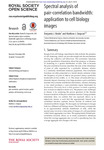Please use this identifier to cite or link to this item:
http://lib.hpu.edu.vn/handle/123456789/22406Full metadata record
| DC Field | Value | Language |
|---|---|---|
| dc.contributor.author | Binder, Benjamin J. | en_US |
| dc.contributor.author | Simpson, Matthew J. | en_US |
| dc.date.accessioned | 2016-07-30T01:39:22Z | |
| dc.date.available | 2016-07-30T01:39:22Z | |
| dc.date.issued | 2015 | en_US |
| dc.identifier.other | HPU4160509 | en_US |
| dc.identifier.uri | https://lib.hpu.edu.vn/handle/123456789/22406 | en_US |
| dc.description.abstract | Images from cell biology experiments often indicate the presence of cell clustering, which can provide insight into the mechanisms driving the collective cell behaviour. Pair-correlation functions provide quantitative information about the presence, or absence, of clustering in a spatial distribution of cells. This is because the pair-correlation function describes the ratio of the abundance of pairs of cells, separated by a particular distance, relative to a randomly distributed reference population. Pair-correlation functions are often presented as a kernel density estimate where the frequency of pairs of objects are grouped using a particular bandwidth (or bin width),_x0002_>0. | en_US |
| dc.format.extent | 15 p. | en_US |
| dc.format.mimetype | application/pdf | en_US |
| dc.language.iso | en | en_US |
| dc.subject | Structural biology and biophysics | en_US |
| dc.subject | Cellular biophysics | en_US |
| dc.subject | Biophysics | en_US |
| dc.subject | Computational | en_US |
| dc.subject | Mathematics | en_US |
| dc.subject | Pair-correlation | en_US |
| dc.subject | Spectral analysis | en_US |
| dc.subject | Spatial patterns | en_US |
| dc.subject | Cell clustering | en_US |
| dc.subject | In vitroassay | en_US |
| dc.title | Spectral analysis of pair correlation bandwidth | en_US |
| dc.type | Article | en_US |
| dc.size | 936KB | en_US |
| dc.department | Education | en_US |
| Appears in Collections: | Education | |
Files in This Item:
| File | Description | Size | Format | |
|---|---|---|---|---|
| 0392_Spectralanalysis.pdf Restricted Access | 936.76 kB | Adobe PDF |  View/Open Request a copy |
Items in DSpace are protected by copyright, with all rights reserved, unless otherwise indicated.
